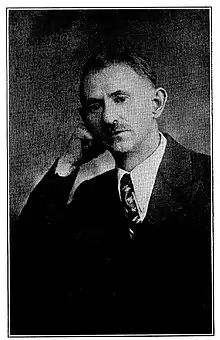Pincus Goodman
Pincus Goodman (Yiddish: פינחס גודמאן, 1881–1947), who published as P. Goodman (פּ. גודמאַן), was an American Yiddish-language poet active from the 1920s to the 1940s.[1] Because he worked as a silk weaver his whole life, he was known as the "weaver poet."[2][3][4]

Biography
Goodman was born in April 1881 in Łowicz, Poland.[5][1][6][7] He had a traditional Jewish education and even considered studying to become a Rabbi before turning from religion to secular politics and becoming a freethinker.[8][3] His parents both died in the 1881–1896 cholera pandemic when he was eight years old, leaving him an orphan.[3][1][8] He became a weaver in Łódź, an important industrial centre in Poland which had a large Jewish silk-weaving industry.[1][9]
He emigrated to the United States in 1902 or possibly 1904, settling in Paterson, New Jersey and continuing to work as a silk weaver for the rest of his life.[10][7][11][12] Paterson was an important centre of Jewish weavers from Lodz and Bialystok who were known for their left-wing politics.[13] He and his family lived in extreme poverty and he never became rich from his silk weaving or his writing.[3] He soon became a member of the Arbeter Ring (worker's circle).[2]
While continuing to work as a weaver, Goodman wrote poetry prolifically, printing pieces in The Jewish Daily Forward, Der Tog, Arbeter, and Fraye arbeter shtime.[3][1] His works described themes of poverty, family, and work.[3] Some of his poems were set to music and became popular in worker's choirs, such as the Kultur-khor directed by Vladimir Heifetz.[3][14] It was only in 1922 that he managed to print his first book of poetry, Veber-lider (weaver songs). In it he made use of the rich Yiddish-language vocabulary of weaving and described the hard life of workers in the industry, two things which rarely appeared in literary works at the time.[15][16] The following year, he published In geshpan: lider un gedikhten ("In Harness: Songs and poems"), which he ended up expanding into a larger volume in a second printing and which grew to five volumes over the next two decades.[1][17] Although they were well regarded, he apparently published them at his own expense.[18][8]
He died on January 23, 1947.[7][2] He was buried in an Arbeter Ring cemetery in Saddle River, New Jersey.[2][4]
Family
He married his first wife Rebecca Pedlock in Łódź in 1902.[8][3][19] They had a number of children: Annie (born 1903), Louis (born 1904), Rose (born 1906), David (born 1910). His first wife died in around 1914 of Bright's disease.[3] He remarried in December 1919 to Rebecca (Becky) Diamond and they had a son Max (born 1921).[20][12][19] Goodman is also the great-grandfather of novelist Tama Janowitz.[8]
Publications
- Veber-lider, also known as Der Ṿeber: balade ("The Weaver, Poems", 1922)[21][1]
- In geshpan: lider un gedikhten volume 1 ("In Harness: Songs and poems" 1926)[1][22][23]
- In geshpan: lider un gedikhten volume 2 (1932)[24][25]
- In geshpan: lider un gedikhten volume 3 (1940)[26]
- In geshpan: lider un gedikhten volume 4 (1945)[1]
- In geshpan: lider un gedikhten volume 5 (1951)[1]
References
- Fogel, Joshua (28 July 2015). "Yiddish Leksikon: PINKHES GUDMAN (PINCUS GOODMAN)". Yiddish Leksikon. Retrieved 18 September 2021.
- "GOODMAN SERVICES". The Record. Hackensack, New Jersey. January 27, 1947. p. 2.
- Wallerstein, Jane (2000). Voices from the Paterson silk mills. Charleston, S.C.: Arcadia. pp. 35–43. ISBN 9780738501970.
- "Pinchus Goodman". The News. Paterson, New Jersey. January 27, 1947. p. 63.
- "Pincus Goodman in the U.S., World War I Draft Registration Cards, 1917-1918". Ancestry. Retrieved 18 September 2021.
- "Pincus Goodman in the U.S., World War II Draft Registration Cards, 1942". Ancestry. Retrieved 18 September 2021.
- Mayzel, Nachman (1955). Ameriḳe in Yidishn ṿorṭ anṭologye (in Yiddish). New York: IKUF. p. 277.
- Pollak, Michael C. (October 24, 1983). "Forsaking her painting and memories". The Record.
- Goldberg, Halina (2016). "Family Picture at an Exhibition". In Veidlinger, Jeffrey (ed.). Going to the people : Jews and the ethnographic impulse. Bloomington: Indiana University Press. pp. 256–81. ISBN 9780253019165.
- "Peter Goodman. Census • New Jersey State Census, 1905". FamilySearch. Retrieved 18 September 2021.
- "Pinkus Goodman. Census • United States Census, 1930". FamilySearch. Retrieved 18 September 2021.
- "Pincus Goodman. Census • United States Census, 1940". FamilySearch. Retrieved 18 September 2021.
- Golin, Steve (1988). The fragile bridge : Paterson Silk Strike, 1913. Philadelphia: Temple University Press. pp. 30–1. ISBN 9781566390057.
- Yardeini, Mordecai (1960). Leo Lyoṿ momenṭn fun zayn lebn un shafn : shṭrikhn tsu a porṭreṭ fun a barimṭer muziḳalisher perzenlekhḳayṭ bay Idn (in Yiddish). New York: Farlag Nigun. p. 145.
- Krul, Chaim; Radoshitzky, J. H. (1954). Ks̀ovim fun Ḥayim Ḳrul a liṭerarishe yerushe ... (in Yiddish). New York: Eygene. p. 122.
- "2. Dos Idishe bikh in Amerike". Dos Naye Lebn: Monaṭlakher Zshurnal Far Ḳulṭur Un Gezelshafṭlakhe Fragn. (in Yiddish). 1 (4): 60. 1923. hdl:2027/mdp.39015028572124.
- Lodzsher almanakh (in Yiddish). New York: Lodzsher brenṭsh. 1934. p. 110.
- Ḳarlin, Aharon (1953). Di Feder zaml-shrifṭ far liṭeraṭur, ḳunsṭ un ḳriṭiḳ (in Yiddish). New York. p. 283.
{{cite book}}: CS1 maint: location missing publisher (link) - "Peter Goodman in the 1910 United States Federal Census". Ancestry. Retrieved 18 September 2021.
- "Pencus Goodman in the New York, New York, U.S., Marriage License Indexes, 1907-2018". Ancestry. Retrieved 19 September 2021.
- Goodman, Pincus (1922). Ṿeber-lider. Paterson, N.J.: H.V. Mandel.
- Goodman, Pincus (1926). In geshpan lider un gedikhṭen 1. New York: P. Goodman.
- אין געשפאן: לידער און געדיכטען. OCLC 150605167. Retrieved 18 September 2021 – via WorldCat.
- Goodman, Pincus (1932). In geshpan lider un gedikhṭen 2. New York: P. Goodman.
- In geshpan. Bd 2. 1932. OCLC 924100600. Retrieved 18 September 2021 – via WorldCat.
- Goodman, Pincus (1945). In geshpan lider un gedikhṭen 3. New York: P. Goodman.
External links
- Pincus Goodman books in the Yiddish Book Center digital library (in Yiddish)